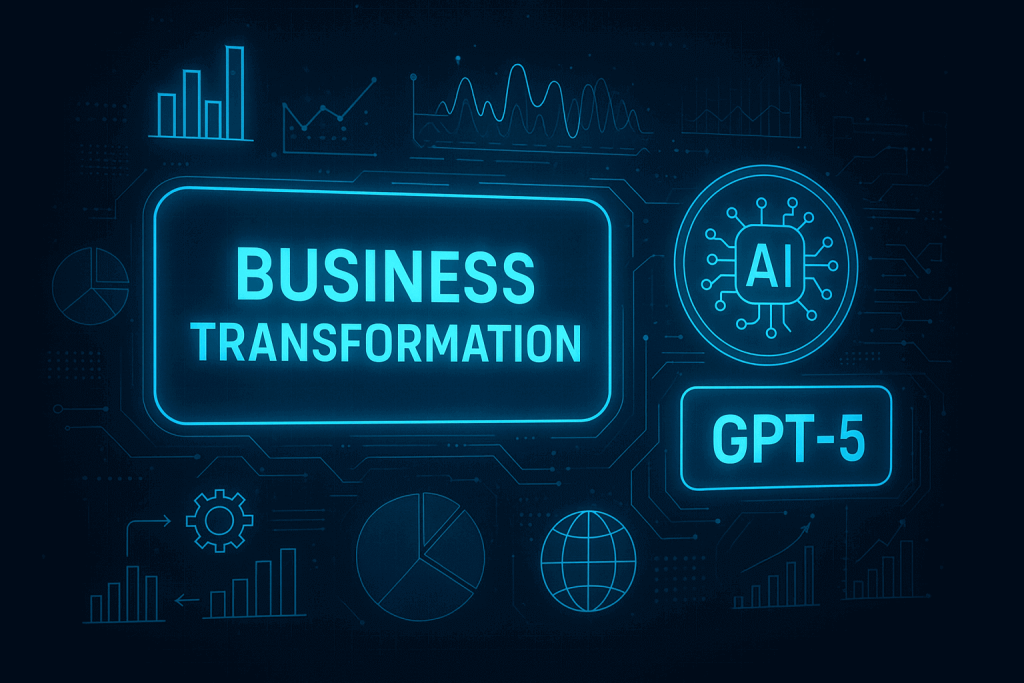Artificial intelligence no longer sits in the distant future, reserved for tech giants and Silicon Valley. Its fifth-generation leap—OpenAI’s GPT-5—is here, accessible for businesses of any size and sophistication. Whether you’re a small business, agency, or a local service provider, the new capabilities of GPT-5 can deliver measurable improvements in productivity, content quality, customer experience, and even growth strategies.
But what actually is GPT-5? How is it different from other “AI” tools you may have tried or heard about? More importantly—how can businesses use it today, even if their team isn’t tech-savvy? Let’s break it down.
Understanding GPT-5: The Next Generation AI
GPT-5 (Generative Pretrained Transformer 5) is the newest version of OpenAI’s advanced language model—a virtual assistant that reads, interprets, and generates natural language and code with astonishing accuracy and nuance. Each “generation” of GPT has learned from billions of examples—emails, articles, reports, websites—making each new version faster, smarter, and safer than before.
The headline: GPT-5 offers “PhD-level intelligence” in its responses, but it’s designed to answer real-world business questions and solve genuine workplace challenges—not just pass academic exams or write poetry.
Unlike mechanical chatbots or shallow “auto-complete,” GPT-5 genuinely understands questions, follows instructions over long conversations, and reasons through complex problems. Instead of simple, quick answers, it provides useful drafts, ideas, summaries, technical details, and even code—tailored to your needs.
How GPT-5 Actually Works (Without the Jargon)
Imagine you have a tireless, always-available digital team member who can:
- Research any topic and deliver an easy-to-read summary.
- Draft emails, blog posts, product descriptions, or social media content from scratch or based on simple prompts.
- Answer customer questions with context and empathy.
- Help you brainstorm new products or services.
- Write or review straightforward code or technical documentation.
- Help organize projects, schedule tasks, and plan next steps.
All you need to do is describe your goal or question—just like you’d ask a helpful colleague—and GPT-5 delivers instantly.
No programming or technical knowledge required. Most modern business tools now integrate GPT-5 “under the hood,” so you can benefit from advanced AI by simply typing, clicking, or speaking.
Key Advantages of GPT-5 for Businesses
Let’s look at the genuine, practical ways GPT-5 stands apart from older AI systems and how those benefits play out in daily business life.
1. Smarter and More Useful Answers
GPT-5 isn’t just fast—it’s insightful. Its improved understanding means your drafts, answers, and reports are more accurate, relevant, and easy to work with. For example, if you ask GPT-5 for ideas on how to grow your business, it won’t just spit out generic advice; it will reason about your industry, audience, and goals.
2. Safer, More Reliable Responses
One issue with previous AI versions was “hallucination”—making up information or missing subtle context. With refined training and safety tools, GPT-5 dramatically reduces these errors. It identifies sensitive topics, avoids risky advice, and knows when to ask for clarification.
3. Deep Integration With Everyday Tools
Big platforms like Microsoft 365, GitHub Copilot, and many web builders already include GPT-5. That means you don’t have to change the way you work or learn complicated software—AI is now built into the programs you know and trust.
4. Faster Results and Better Collaboration
From meeting notes and brainstorming sessions to first drafts of articles or emails, GPT-5 speeds up creation while collaborating in your team’s style. Your team can edit, track changes, and guide the model, keeping the “human touch” in every aspect.
What Can GPT-5 Do For Your Business?
GPT-5 is not just for writing; it can support nearly every business function:
Content Creation & SEO
- Drafts thorough, engaging blog posts, product pages, and newsletters.
- Suggests keywords, subtopics, and outlines for SEO-targeted content.
- Refreshes old web pages with timely updates and improved structure.
- Generates FAQs and “how-to” sections for website visitors.
- Proposes internal links and schema markups for better Google visibility.
Customer Service
- Responds instantly to customer queries via chat, email, or SMS.
- Crafts personalized, polite replies, even for tough questions or complaints.
- Summarizes long customer conversations—handy for support teams.
- Automates routine responses, increasing satisfaction and freeing up your team.
Sales and Marketing
- Analyzes the market to suggest campaign ideas, product angles, and messaging.
- Prepares sales scripts, product comparisons, and competitor overviews.
- Constructs high-impact headlines and calls-to-action for ads and landing pages.
- Drafts email sequences for different stages of the customer journey.
Social Media and Branding
- Generates creative post ideas, hashtags, and visual descriptions.
- Schedules updates and analyzes engagement across platforms.
- Maintains brand voice by generating guidelines and example copy.
- Helps with reputation management by responding to reviews and comments.
Project Management and Everyday Operations
- Organizes meeting notes, deadlines, and key takeaways.
- Sets up checklists and assigns action steps for team members.
- Translates complex instructions into simple, usable guides.
- Tracks progress and suggests workflow improvements.
Research and Decision Support
- Summarizes industry reports, competitor moves, and market trends.
- Digests data—large or small—into actionable insights.
- Compares product features or prices for easier decision-making.
- Prepares memos, business plans, and proposal drafts.
Technical Assistance (For Non-Coders Too!)
- Helps draft, review, and debug simple code for websites or apps.
- Explains technical terms in plain language.
- Prepares documentation for new tools or processes.
Practical Examples for Everyday Businesses
Let’s imagine some common scenarios:
A Neighborhood Café
- Wants to announce new specials every week and answer reviews.
- GPT-5 drafts fun, inviting posts for Instagram and Facebook; writes responses to Google reviews; updates the website’s menu automatically.
Independent Contractor
- Needs to send periodic newsletters and keep current on insurance regulations.
- GPT-5 drafts the email sequence, researches changes in rules, and prepares “tip sheets” for clients.
Small Retail Store
- Wants to improve online product descriptions and handle customer questions after hours.
- GPT-5 writes compelling descriptions, answers shopper queries in chat, and follows up on abandoned carts.
Consulting Agency
- Manages project deadlines, creates case studies, and pitches new services.
- GPT-5 organizes project notes, drafts polished reports from bullet points, and builds proposal templates.
Getting Started With GPT-5 (A Friendly Guide)
If you’re ready to dip your toes into AI, it’s easier than ever. Here’s a simple approach:
Step 1: Identify a Task
Is there something your team spends too much time on—like writing emails, updating the website, researching new trends, or answering customer questions?
Step 2: Find a Tool With GPT-5 Integration
Check your current software (email tools, web platforms, chat services) for GPT-5 or “AI-powered” helpers. Many solutions are plug-and-play; no installation needed.
Step 3: Start With Simple Prompts
You don’t need perfect instructions. Try prompts like:
- “Draft an email inviting customers to our summer sale.”
- “Write a blog post about our new product with three key benefits.”
- “Summarize today’s team meeting for the website.”
Step 4: Review and Adjust
You stay in control—GPT-5 offers drafts, but you approve, edit, and personalize before publishing.
Step 5: Expand Gradually
As you get results, use GPT-5 for new tasks—FAQs, newsletters, support guides, or market reports.
Common Questions (And Straight Answers)
Will GPT-5 take away jobs?
No. AI works best as an assistant—handling tedious tasks and letting staff focus on creativity, strategy, and service. Businesses prosper by combining the strengths of machines and people.
Is GPT-5 safe and responsible?
OpenAI and partners have put extensive safeguards in place. GPT-5 avoids giving risky or offensive advice, tries to verify facts, and can identify when a person’s review is needed.
Do I need special training to use it?
No special skills required. If you can send an email or fill out a form, you’re ready for GPT-5. The tools are intuitive and designed for everyday use.
Will my content sound too “robotic”?
Not anymore. GPT-5 can match your brand’s tone—friendly, professional, casual, or serious. You always check final drafts for approval.
Is it expensive?
Starting costs are lower than hiring extra staff or outside services. Most AI-powered features come bundled with commonly used software. For small businesses, these tools are now very affordable.
Best Practices for Business Owners
- Always review GPT‑5’s results. AI is excellent, but the best results come from collaboration with people who know their business.
- Provide clear instructions. Specify audience, desired tone, and any do’s or don’ts.
- Keep sensitive data private. Don’t share confidential info unless you know data handling is secure.
- Integrate gradually. Start with one workflow, measure results, and expand as you gain confidence.
- Measure impact. Track time saved, improved engagement, and feedback from customers.
- Solicit employee feedback. Encourage your team to use AI and report what works or needs adjusting.
Looking Ahead: The Broader Impact of GPT-5
For many businesses, GPT-5 signals a bigger shift: from manual, repetitive work, to smarter workflows led by human creativity. Instead of spending hours researching, writing, or responding to emails, people can focus on new ideas, customer relationships, and growth.
This isn’t the end of the story. AI will keep improving, and businesses who start early will be the ones leading their industries—not scrambling to keep up. By adopting GPT-5 thoughtfully, teams become faster, more capable, and more resilient in changing times.
The Bottom Line
GPT-5 makes artificial intelligence ordinary—useful not just for techies or big corporations, but for anyone looking to work smarter in 2025. It drafts, analyzes, organizes, and answers, with a depth and nuance not seen in previous versions.
For business owners and managers, that means less stress, more success, and new opportunities to connect with customers and grow your brand.
Embrace GPT-5—not as a replacement, but as your newest and most tireless teammate. The future is now open to everyone.




